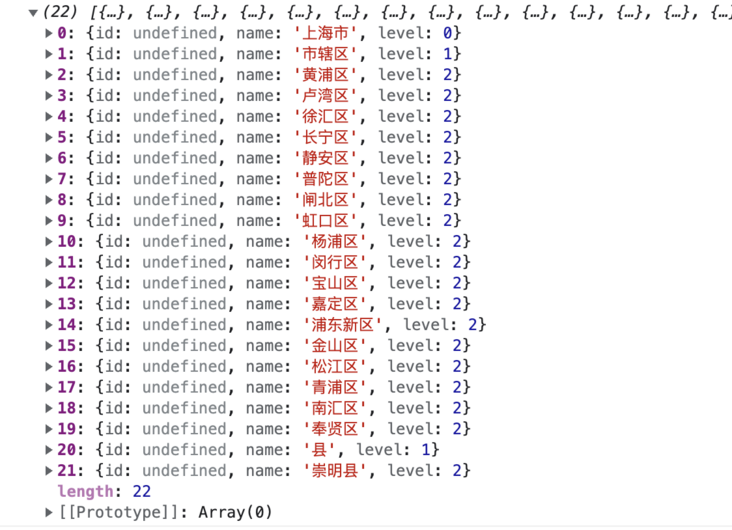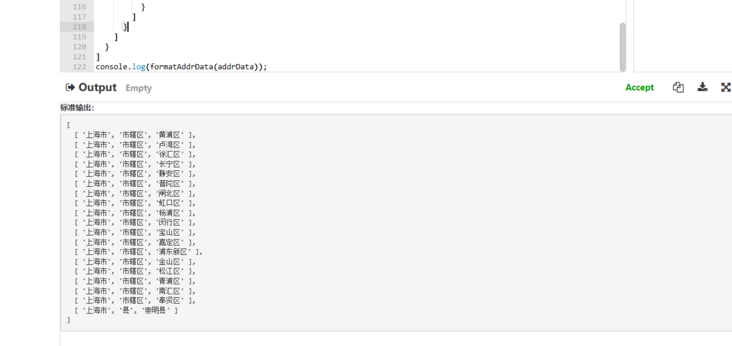问题:

javascript - js如何将树形结构数组对象变为二维数组?
司马庆
有个以下格式的省市区数组对象:
[
{
"name": "上海市",
"child": [
{
"name": "市辖区",
"child": [
{
"name": "黄浦区",
"child": null
},
{
"name": "卢湾区",
"child": null
},
{
"name": "徐汇区",
"child": null
},
{
"name": "长宁区",
"child": null
},
{
"name": "静安区",
"child": null
},
{
"name": "普陀区",
"child": null
},
{
"name": "闸北区",
"child": null
},
{
"name": "虹口区",
"child": null
},
{
"name": "杨浦区",
"child": null
},
{
"name": "闵行区",
"child": null
},
{
"name": "宝山区",
"child": null
},
{
"name": "嘉定区",
"child": null
},
{
"name": "浦东新区",
"child": null
},
{
"name": "金山区",
"child": null
},
{
"name": "松江区",
"child": null
},
{
"name": "青浦区",
"child": null
},
{
"name": "南汇区",
"child": null
},
{
"name": "奉贤区",
"child": null
}
]
},
{
"name": "县",
"child": [
{
"name": "崇明县",
"child": null
}
]
}
]
}
]请问如何用Ts变为以下格式的二维数组?
[
['上海市', '市辖区', '黄浦区']
['上海市', '市辖区', '卢湾区']
['上海市', '市辖区', '徐汇区']
['上海市', '市辖区', '长宁区']
['上海市', '市辖区', '静安区']
['上海市', '市辖区', '普陀区']
['上海市', '市辖区', '闸北区']
['上海市', '市辖区', '虹口区']
['上海市', '市辖区', '杨浦区']
['上海市', '市辖区', '闵行区']
['上海市', '市辖区', '宝山区']
['上海市', '市辖区', '嘉定区']
['上海市', '市辖区', '浦东新区']
['上海市', '市辖区', '金山区']
['上海市', '市辖区', '松江区']
['上海市', '市辖区', '青浦区']
['上海市', '市辖区', '南汇区']
['上海市', '市辖区', '奉贤区']
['上海市', '县', '崇明县']
]共有7个答案
笪涛
使用递归的方式来解决,并且使用尾递归进行优化
interface Item {
name: string
child: Item[] | null
}
function transformItem(item: Itme, result: string[]) {
if (item.child === null) {
return [...result, item.name]
}
return item.child.map(c => transformItem(c, [...result, item.name]))
}
function main(items: Item) {
return items.flatMap(item => transformItem(item, []))
}龚志文
// 将树形结构数组对象转换为二维数组
function flattenTreeArray(treeArray) {
const result = [];
function flatten(node, level) {
result.push({
id: node.id,
name: node.name,
level: level
});
if (node.child && node.child.length > 0) {
node.child.forEach(child => {
flatten(child, level + 1);
});
}
}
treeArray.forEach(node => {
flatten(node, 0);
});
return result;
}
郭永安
interface TreeNode {
name: string;
child?: TreeNode[]|null;
}
function getTreeNames(list: TreeNode[]): string[][] {
const dfs = (list: TreeNode[], result: string[][] = [], names: string[] = []): string[][] => {
return list.reduce((res,node) => {
// 先把遍历到的节点name存起来,即先(前)序遍历
names.push(node.name);
// 深度遍历节点
// 遍历到叶子节点时拷贝name数组push进结果【数组是引用类型,故需要拷贝一次】
if(node.child && node.child.length) dfs(node.child, res, names)
else res.push(names.slice())
// 回溯name
// 当执行至这里时代表已经到达叶子节点,要返回到上一级节点了,故要把刚push的name推出
names.pop();
return res;
}, result);
}
// 外层的getTreeNames实际上只是为了隐藏内部的dfs函数的另外两个参数
// 也可以考虑去除外层包装直接将dfs作为getTreeNames
return dfs(list)
}
getTreeNames(data)东门奕
function tree2arr(tree) {
var ret = [];
var depth = [];
var values = [];
var stack = tree.slice();
while (stack.length) {
var top = stack.pop();
values.push(top.name);
if (top.child) {
depth.push(top.child.length);
stack.push.apply(stack, top.child);
} else {
ret.unshift(values.slice());
do {
values.pop();
} while (!--depth[depth.length - 1]);
}
}
return ret;
}
var tree = [{
"name": "上海市",
"child": [{
"name": "市辖区",
"child": [{
"name": "黄浦区",
"child": null
},
{
"name": "卢湾区",
"child": null
},
{
"name": "徐汇区",
"child": null
},
{
"name": "长宁区",
"child": null
},
{
"name": "静安区",
"child": null
},
{
"name": "普陀区",
"child": null
},
{
"name": "闸北区",
"child": null
},
{
"name": "虹口区",
"child": null
},
{
"name": "杨浦区",
"child": null
},
{
"name": "闵行区",
"child": null
},
{
"name": "宝山区",
"child": null
},
{
"name": "嘉定区",
"child": null
},
{
"name": "浦东新区",
"child": null
},
{
"name": "金山区",
"child": null
},
{
"name": "松江区",
"child": null
},
{
"name": "青浦区",
"child": null
},
{
"name": "南汇区",
"child": null
},
{
"name": "奉贤区",
"child": null
}
]
},
{
"name": "县",
"child": [{
"name": "崇明县",
"child": null
}]
}
]
}];
console.log(tree2arr(tree));江敏学
const paths = (items, pathKey, childrenKey) => {
const _path = (items, result, parents) => {
if(items && items.length) {
items.forEach(item =>
_path(item[childrenKey], result, [...parents, item[pathKey]]));
return;
}
if(parents.length) {
result.push(parents);
}
};
const result = [];
_path(items, result, []);
return result;
}
// const items = [...];
// const result = paths(items, 'name', 'child');
// console.log(result);柴飞扬
有两种递归方式,一种是最外层等待内部递归的结果,然后进行拼接;另一种是把当前的name传递给内层,直到最内层child为null,然后拼接路径。
如果是 ts 的话,我们先声明一个树形结构的类型:
interface TreeItem {
name: string;
child?: TreeItem[];
}外层等待内层的递归结果
const transform = (tree: TreeItem[]) => {
let result: string[][] = [];
tree.forEach((item) => {
if (item.child) {
// 得到子元素的数组
const childList = transform(item.child);
result = result.concat(
childList.map((child) => {
// 对每个子元素,都拼接上当前元素的name
return [item.name].concat(child);
})
);
} else {
result.push([item.name]);
}
});
return result;
};这种方式比较绕。
外层元素递归传给内层
const transform = (tree: TreeItem[]) => {
const result: string[][] = []; // 声明一个全局变量,用来存储递归结束时的数据
const find = (list: TreeItem[], parents: string[] = []) => {
list.forEach((item) => {
const path: string[] = parents.concat(item.name);
if (item.child) {
find(item.child, path);
} else {
result.push(path);
}
});
};
find(tree);
return result;
};欧照

interface AddrItem {
name: string;
child: AddrItem[] | null;
}
function formatAddrData (data: AddrItem[]): string[][] {
const result: string[][] = [];
function traverse (addrList: AddrItem[], path: string[]): void {
if (!addrList || addrList.length === 0) {
return;
}
for (const item of addrList) {
const newPath = [...path, item.name];
if (!item.child || item.child.length === 0) {
result.push(newPath);
} else {
traverse(item.child, newPath);
}
}
}
traverse(data, []);
return result;
}
const addrData = [
{
"name": "上海市",
"child": [
{
"name": "市辖区",
"child": [
{
"name": "黄浦区",
"child": null
},
{
"name": "卢湾区",
"child": null
},
{
"name": "徐汇区",
"child": null
},
{
"name": "长宁区",
"child": null
},
{
"name": "静安区",
"child": null
},
{
"name": "普陀区",
"child": null
},
{
"name": "闸北区",
"child": null
},
{
"name": "虹口区",
"child": null
},
{
"name": "杨浦区",
"child": null
},
{
"name": "闵行区",
"child": null
},
{
"name": "宝山区",
"child": null
},
{
"name": "嘉定区",
"child": null
},
{
"name": "浦东新区",
"child": null
},
{
"name": "金山区",
"child": null
},
{
"name": "松江区",
"child": null
},
{
"name": "青浦区",
"child": null
},
{
"name": "南汇区",
"child": null
},
{
"name": "奉贤区",
"child": null
}
]
},
{
"name": "县",
"child": [
{
"name": "崇明县",
"child": null
}
]
}
]
}
]
console.log(formatAddrData(addrData));
类似资料:
-
题目描述 希望将上面数组用js转化成下面格式,请问如何实现呢
-
扁平数组的结构如上,每个目录下都可以添加数据 如何将这个数组转成树形的结构啊,转成如下的形式 目录层级的name就取对应的 xxxLevelStr
-
转为 用num作为key
-
问题内容: 如果我在C#中有一个二维数组-如何将其转换为包含二维数组的JSON字符串? 例如。 在JSON对象中给出一个平面的一维数组。Microsoft文档指出: “多维数组被序列化为一维数组,应该将其用作平面数组。” 问题答案: 您可以使用锯齿状数组而不是二维数组,其定义如下: 然后,JavascriptSerializer会将其序列化为[[#,#,#,#],[#,#,#,#]等形式]
-
我正在学习图的结构和算法。从概念上讲,我理解DFS、BFS,并且我可以通过一个图来实现它们,但是传统上图是如何组成的呢? 通常,我将它们看作是以边为指针的节点列表、与它们连接的节点的边列表,或者是一个2D矩阵,其中两个节点的交点arr[node_a][node_b]是边的权重。 当涉及到实际构建它的输入,我不知道从哪里开始。
-
问题内容: 我已经有了用于将一维二维转换为一维二维的代码,但是我不知道如何将其转换。这是我的代码: 问题答案: 您正在寻找类似的东西: 与以下内容相同: 但试图帮助进一步解释这个概念。

